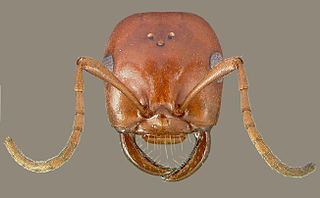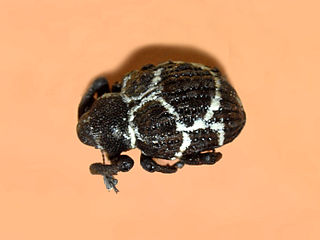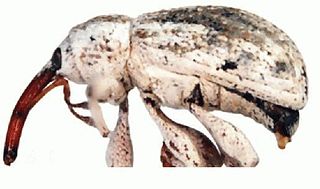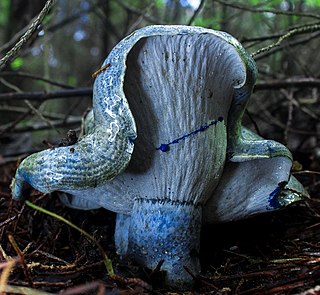
Polyergus is a small genus of ants with 14 described species. They are also referred to by the names "slave-raiding ants" and "Amazon ants". They are characterized by their habit of raiding nests for workers.
Didymopanax is a genus of flowering plants in the family Araliaceae, native to southern Mexico, Central America, the Caribbean, and South America. It was resurrected from Schefflera in 2020.

Nautilocalyx is a genus of plants in the family Gesneriaceae. Its native range stretches from Costa Rica to southern Tropical America and to Trinidad. It is also found in Bolivia, Brazil, Colombia, Costa Rica, Ecuador, French Guiana, Guyana, Panamá, Peru, Suriname, Trinidad-Tobago and Venezuela.
Nautilocalyx vinosus is a species of plant in the family Gesneriaceae. It is endemic to Ecuador. Its natural habitat is subtropical or tropical moist lowland forests.
Sarcomyces is a genus of fungi in the Helotiales order. The relationship of this taxon to other taxa within the order is unknown, and it has not yet been placed with certainty into any family. This is a monotypic genus, containing the single species Sarcomyces vinosus.

Lactarius sanguifluus, commonly known as the bloody milk cap, is a species of fungus in the family Russulaceae. First described from France in 1811, the species was given its current name by Elias Fries in 1838 when he transferred it to Lactarius. Found in Asia, Mediterranean Africa, and Europe, fruit bodies (mushrooms) grow scattered or in groups on the ground under conifers, especially Douglas fir. When bruised or cut, the fruit bodies ooze a blood-red to purple latex that slowly turns greenish upon exposure to air. The caps are orangish to reddish-brown, and become funnel-shaped with age. The gills are pinkish to purplish. Different forms have been described from Italy, but these are not universally accepted as distinct. L. sanguifluus mushrooms are edible, and sold in rural markets of Europe and Asia. Fruit bodies grown in polluted soil, including roadsides subject to heavy traffic, can bioaccumulate toxic heavy metals. Several sterols and pigment have been isolated and identified from the mushrooms.

Desmidophorus is a genus of weevils in the family Brachyceridae.
Toxitiades is a genus in the longhorn beetle family Cerambycidae. There are about nine described species in Toxitiades, found in Madagascar.
Toxitiades vinosus is a species of beetle in the family Cerambycidae. It was described by Fairmaire in 1893.

Myagrus is a genus of longhorn beetles of the subfamily Lamiinae, containing the following species:

Nigroporus vinosus is a species of poroid fungus in the family Steccherinaceae, and the type species of the genus Nigroporus. Its fruit bodies have brownish caps with tinges of purple or red. The cap underside has a pore surface the same colour as the cap, and minute pores. Nigroporus vinosus has a pantropical distribution. It has been recorded from Africa, North America, Central America, South America, Asia, and Oceania. It is a wood-decay fungus that causes a white rot.
Myagrus alboplagiatus is a species of beetle in the family Cerambycidae. It was described by Charles Joseph Gahan in 1888. It is known from Borneo.
Myagrus javanicus is a species of beetle in the family Cerambycidae. It was described by Stephan von Breuning in 1957. It is known from Java.
Himatolabus is a genus of leaf-rolling weevils in the beetle family Attelabidae. There are about 16 described species in Himatolabus.

Epimechus is a genus of true weevils in the beetle family Curculionidae. There are more than 20 described species in Epimechus.
Anolis vinosus is a species of lizard in the family Dactyloidae. The species is found in Haiti.

Hypomyces lateritius, the ochre gillgobbler, is a parasitic ascomycete fungus that grows on certain species of Lactarius mushrooms, improving their flavor and densifying the flesh. Hosts include L. camphoratus, L. chelidonium, L. controversus,L. deliciosus, Lactarius indigo, L. rufus, L. salmonicolor, L. sanguifluus, L. semisanguifluus, L. tabidus, L. trivialis, and L. vinosus.
Stachystemon vinosus is a species of flowering plant in the family Picrodendraceae and is endemic to the southwest of Western Australia. It is a compact, monoecious shrub with narrowly egg-shaped or narrowly oblong leaves and maroon to purplish red and white male flowers and white female flowers arranged singly in upper leaf axils, but forming clusters at the ends of branches.
Stachystemon virgatus is a species of flowering plant in the family Picrodendraceae and is endemic to the southwest of Western Australia. It is a compact monoecious shrub with elliptic or narrowly oblong leaves and small yellow flowers arranged singly in upper leaf axils.
Costus vinosus is a critically endangered species of plant in the family Costaceae which may now be extinct in the wild. It is endemic to Panama. Costus vinosus was first described by Paul Maas in 1976. As of 2015 Costus vinosus could still be found in the wild.







